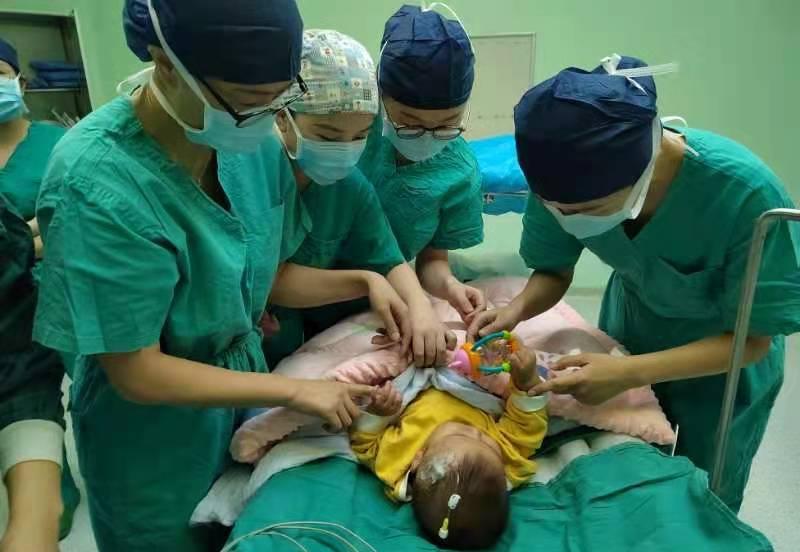
After 20 days, the Third Affiliated Hospital of the Naval Military Medical University (Shanghai Oriental Hepatobiliary Surgery Hospital) successfully treated young children with giant hepatoblastoma and removed nearly 1/8 of the children's body weight. Recently, the child has been successfully discharged from the hospital.
The time is dialed back to the evening of November 11.
On that day, the intensive care unit of Shanghai Oriental Hepatobiliary Surgery Hospital received a request for consultation, and the subject of the consultation asked the medical staff to take a breath of cold air. It was Chong Chong (pseudonym), a five-month-old child who had just been admitted to the hospital, and because of crying, his huge hepatoblastoma in his abdominal cavity ruptured and needed an emergency indwelling central venous catheter.
Hepatoblastoma is a malignant embryonic tumor that originates in the liver, most cases occur before the age of 3 years, and is the most common liver tumor in childhood, accounting for about 60% of primary hepatic malignancies in children.
But Chong Chong's situation is more different, just 5 months old, his tumor has grown to the size of an adult's fist, occupying three-quarters of the liver. From the perspective of MRI, the tumor is tightly surrounded by major blood vessels in the liver, and the situation is dangerous and urgently needs surgery. Previously, Chong Chong's parents had taken him to a number of well-known hospitals, all of which were told that there was no chance of surgery because the child was too young and the operation was too difficult.
Under comprehensive research and judgment, Yang Guangshun, a professor of the Five Departments of Hepatology at Shanghai Oriental Hepatobiliary Surgery Hospital, decided to admit him to the hospital and try to prepare for the removal of the tumor before surgery. Not wanting to prepare before it was completed, there was a rupture accident, which was tantamount to making the already difficult treatment worse. At that time, the rush of hemoglobin had dropped to half of the normal level, the vital signs began to be unstable, and the relatively simple central vein puncture in the usual days had become a race with the god of death here.
With the cooperation of the three departments of the hospital, the rescue work was carried out in an intense and orderly manner: Tao Yong, anesthesiologist, inserted a tracheal catheter thinner than a pencil in the child's airway, and the general anesthesia was successfully completed. Through ultrasound guidance, Associate Professor Zhang Jinmin successfully placed an internal jugular venous catheter on the neck of a child with only one finger width, and the child's vital signs were stable. After careful observation, there was no need for emergency surgery for the time being, and everyone breathed a sigh of relief.
After continuing treatment in the intensive care unit for three days, Chong Chong turned the crisis around and the operation officially began. No, during the operation, it was found that the actual situation of chong chong was more serious than the preoperative MRI, only a quarter of the liver could be retained, in the three important liver veins, two of which had been swallowed by the tumor, and the remaining one was also severely stressed.
Because of the size of the tumor, each step requires hemostatic forceps to tossing and turning between several important blood vessels. Fortunately, with rich experience in diagnosis and treatment, Yang Guangshun's team calmed down and successfully removed almost 1/8 of the child's body weight.
The operation ended smoothly, Chong Chong was transferred to the ICU again, and the trauma and pain of the operation caused his heart rhythm to reach 200 beats per minute at one point. Guardianship assessment, rehydration transfusion, sedation and analgesia, medical staff carefully cared for the small life, and the vital signs of Chong Chong finally gradually returned to normal. After 9 days, the indicators of the rush gradually returned to normal.
On the day of discharge, the innocent and bright smile returned to Chong Chong's face. Yang Guangshun was very pleased, "Looking at the child's smile, it seems that the ordeal he endured before was just a nightmare, and it didn't really happen." "Only those who are standing on the sidelines know how hard it all was.
Author: Li Chenyan
Edit: Wang Xing
Editor-in-Charge: Fan Liping
Image source: Courtesy of the hospital
*Wenhui exclusive manuscript, please indicate the source when reprinting.